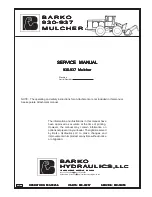
214880
44
Revision A
3.8
Header Settings
Satisfactory operation of the disc header in all situations requires making proper adjustments to suit various crops and
conditions.
Correct operation reduces crop loss and increases productivity. Proper adjustments and timely maintenance increases the
length of service of the machine.
The variables listed in the following table and detailed in this manual, affect the performance of the disc header. Most of
the adjustments have been set at the factory, but settings can be changed to suit your crop conditions.
Table 3.1 Header Operating Variables
Variable
Refer to
Float
Header angle
3.8.2 Adjusting Cutterbar Angle, page 45
Cutting height
Ground speed
Conditioner Settings
Crop Stream Configuration
3.9 Reconfiguring Cutterbar Crop Stream, page 47
3.8.1
Cutting Height
Cutting height is determined by a combination of the cutterbar angle and the optional gauge roller or skid shoe settings if
installed. Adjust cutting height for optimum cutting performance while preventing excessive build-up of mud and soil inside
the disc header, which can lead to poor crop flow and increased wear on cutting components.
Optional adjustable gauge rollers and skid shoes are available to provide different cutting heights. Refer to:
•
5.1.2 Adjustable Gauge Roller Kit, page 153
•
5.1.3 Adjustable Skid Shoes Kit, page 154
Lowering the skid shoes (or gauge rollers) and decreasing the cutterbar angle increases the cutting height, resulting in
higher stubble that helps material dry faster. This may be desirable in stony conditions to help reduce damage to cutting
components.
Raising the skid shoes (or gauge rollers) and increasing the cutterbar angle decreases the cutting height, resulting in a
shorter stubble.
To choose a header angle that maximizes performance for your crop and field conditions, refer to
.
To minimize cutterbar damage, scooping soil, and soil build-up at the cutterbar in damp conditions, the float should be set
as light as possible without causing excessive bouncing. Refer to
.
















































